A few weeks ago, I challenged myself by changing my normal sketching kit to a waterbrush (a large Pentel Aquash) and a small palette (see this article for more details), and I decided that this is what I would take down to Melbourne as well!
I wanted to see how long I would last using the waterbrush (instead of my normal dagger brush) and the small palette (instead of my normal palette – see here) and which I would abandon first.
Can you guess which one it was?
I don’t like the fact that waterbrushes result in flatter watercolour washes (with less pigment parties) and are not as good to use for large areas. I also miss using a dagger brush head.
With the smaller palette, I find it hard to mix subtle washes (such as a buff colour – see here) and generally hard to mix larger amounts of paint. But it’s such a nice palette – it’s small, easy to open up and hold (especially when sketching standing up, which I did a lot of in Melbourne).
I was constantly more frustrated with the waterbrush than the small palette, so it would have been logical to abandon it first. However, I was very determined to get good results from the waterbrush and was reluctant to give it up.
So, I went back to my normal palette! It was MUCH easier to use with a waterbrush, and I’m now relatively happy with the results I’m getting.
I’m always aiming to achieve watercolour washes with lots of pigment parties. To do this with a waterbrush, I need to mix washes with lots of pigment and plenty of water (more than normal), so it makes sense that a palette with good mixing wells is important.
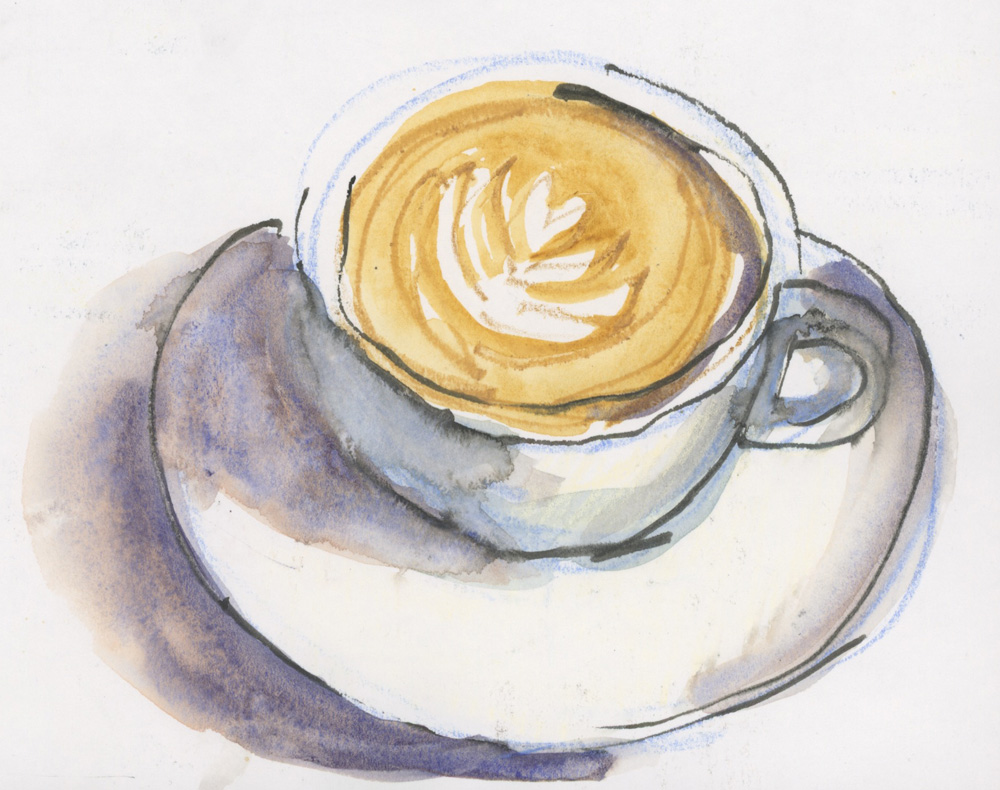 As I’m using a lot of water in these washes, there is always a risk of backruns. But as I love texture and happy accidents, that’s ok with me.
As I’m using a lot of water in these washes, there is always a risk of backruns. But as I love texture and happy accidents, that’s ok with me.
Are you surprised that I’m still using the waterbrush?
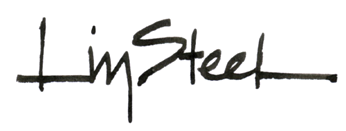
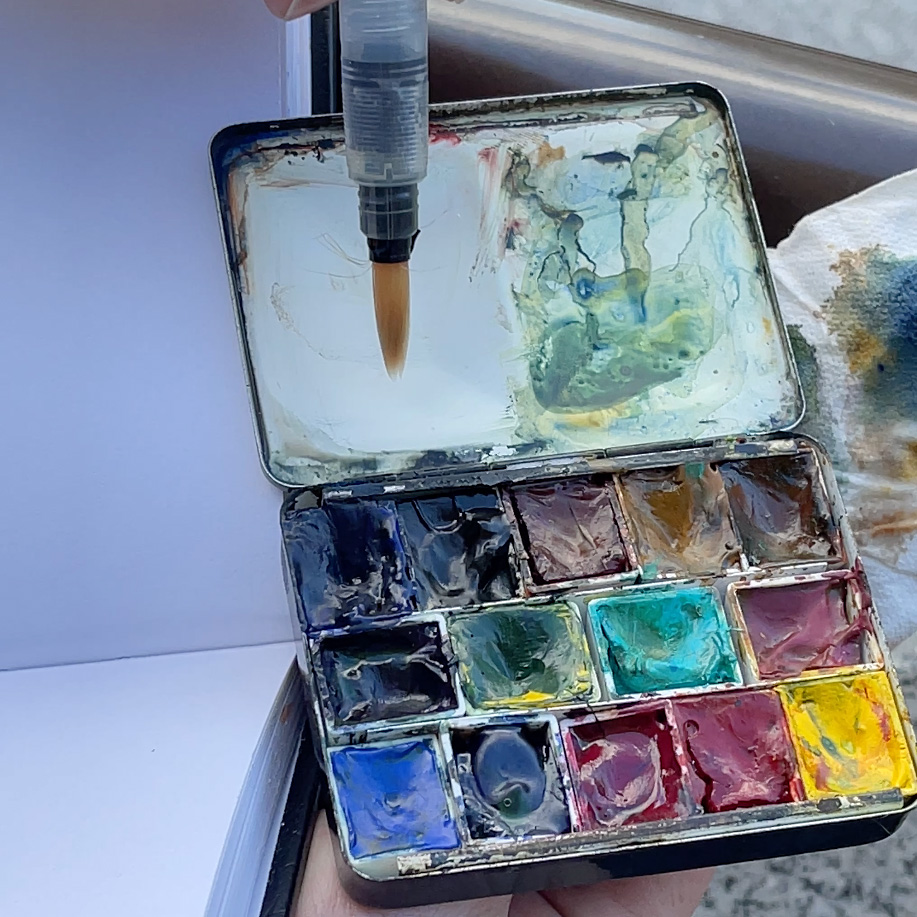
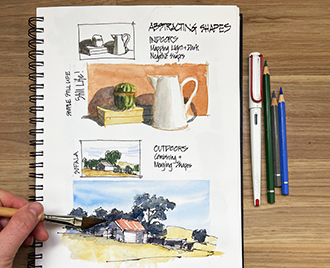

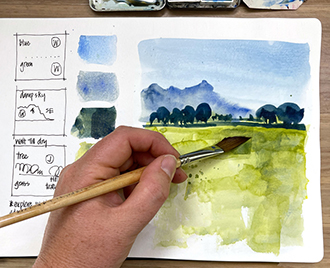
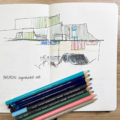
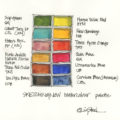
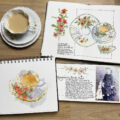
35 Comments
I am very surprised, would not think that mixing space can be that much of a problem. I would love to see maybe small video on how you mix a wash with water brush to understand
Hi Natalia – I filmed some demos using it in my next online course – so stay tuned for that.
But mixing area is important for large areas and because of the amount of water I’m using in my washes.
Wow, I’m surprised by that as well! 😀 Your explanation makes perfect sense, though. Once you’ve finished the waterbrush experiment, I’d love to see a tally such as number of sketches completed with waterbrush vs number of sketches completed with small palette. 🙂 I guess I’m a bit nerdy like that, haha.
Take care, and happy sketching! 🙂 <3
Hi London – well since I’ve switched to my normal palette and I’m still using the waterbrush the ratio is only going to increase. For my Melbourne trip nearly 100% waterbrush, 50% smaller palette until I switched.
I would’ve thought you would’ve chucked the water brush first! I am always frustrated by water brushes. Do you squeeze out water directly from the brush into the mixing pans and does the water brush hold enough water to get through a whole sketch? I’d love to know more about how to use one successfully.
Hi Terri – I’ve really getting used to my waterbrush and it’s becoming much easier to get good results. Yes, I squeeze extra water when I’m mixing. And generally the waterbrush reservoir lasts for multiple sketches. I carry two with me and didn’t run out even though doing 10 sketches in a day. But I don’t layer much or do big background washes
I was surprised! For a moment, then I remembered how tenacious you are, in a good way, and it makes sense that you prioritized achieving gorgeous washes over convenience. This coffee is fantastic, so happy you are conquering the waterbrush and finding the path to make it work!
Hi Katie – yes, I don’t like to get up… and I don’t expect to master anything overnight. It’s becoming much easier to get results I’m happy with now!
I don’t think that this battle between regular and waterbrushes can be resolved when it comes to the plain air. From what I’ve seen my setup is very light (lighter than your smallest palett) but yet I carry both pentel and a regular brush. The size of the painting and the ability to use a water cup determins it for me. I can’t imagine using regular brush while in plublic transport…
Thanks for sharing Marta. and yes, I carry both and soon will probably go back to my dagger as the default brush.
I am surprised you have found you can be happy with the results. I liked playing around with the flat waterbrush by Kuretake but mostly for drawing with the brush so I think for small sketches with lots of white paper I will try it for a bit. And use some ink after doing the watercolor. Thanks to everyone for all the helpful comments, too!!
Hi Pat – I’m a bit surprised too, but the waterbrush is getting so much easier and second nature now! That makes me very happy as it is so convenient!
Hi Liz…I am surprised water brush is still standing!! Love my 1/4” and 1/2” Rosemary dagger brushes! Just can’t get soft, flowing connection with water brush. Love small palette, however… need much more mixing space that I can return to. Have added a few 4” x 6” clear plastic lids to extend mixing area. Lightweight, easily wiped clean and stacked upon each other requires little space. Use many securely lidded medication/vitamin containers for holding water.
Always appreciate your inspirations!!! Appreciate you!!
Thanks Suzie – and yes, no comparison at all with a dagger brush! But it’s good to challenge myself
Recently I did a canoe camping trip where I found a water brush and small palette relieved the usual frustration I experience trying to get sketches done while engaged in group activities. I put together a minimalist kit containing a small sketchbook, pen, mechanical pencil, 2 watercolor pencils, a water brush, and a tiny palette. For the palette, I used a weekly medication box that has a small compartment for each day of the week. I filled the compartments with: 1 each of warm and cool reds, yellows, and blues, and for the last compartment, burnt sienna. Beforehand I made a pigment mixing chart to see all the colors I could get with these limited paint choices. On the trip, using the water brush, I mixed colors directly on the paper. This was great practice for me and I was pleased with the results. No frustration and lots of pigment parties!
Sounds a great solution!
Hi Mary – thanks for sharing – so happy to read that it worked for you and you got lots of pigment parties.
I love reading about all your experiments Liz. I hear you re the mixing areas being super important. I’ve found that too. And keenly await, with others, more images of you in action! Do you attach your normal palette to your sketchbook? I think you’re not using your usual support board at the moment, or a modified one?
Hi Ginie – yes that’s correct, I’m not using a support board these days. Haven’t to date attached my palette to anything but holding it in my right hand using the thumb ring.
Actually yes. you didn’t seem like you liked working with either. you’re paintings seemed less complete with the water brush and small palette… like you didn’t enjoy it so you stopped sooner.
Hi Stacey, I love a challenge and want to get good results using them. It’s easy to give up too soon 🙂 So even though I didn’t like the results I was still enjoying the convenience!
just read all the comments…everyone has a different take… as they should. love the colours for the tea cup. so smooth.
Thanks – I was happy with this coffee cup sketch!
That’s interesting! Lately I’ve been enjoying flat waterbrushes as they seem to work better with pigments. To me, the results look more spontaneous as well, with very interesting results when using them for both narrow and wider strokes.
Hi Maria, Yes I would like to try a flat waterbrush as well. In the past I’ve found them too dry but who knows now that I’m so much more comfortable using water brushes in general.
I am surprised you are still sticking with the Pentel water brush. I have found them harder to control the water release than other brands, perhaps because the plastic bladder is softer to squeeze inadvertently. I am training myself to not release water as I am painting, and to lightly dab the brush tip on a cloth before I pick up a mix from the tray. I also made a small foam board platform on which to secure my A6 sketchbook for stability. It has a velcro strip to attach my tiny mint container palette and a bottle cap for an extra mixing well. I really enjoy following you on your blog to see what you are currently experimenting with, Liz!
Hi Naomi, the Pentel Aquash is by far my favourite brush – I prefer a wetter tip for a waterbrush and find Niji and other brands too dry for me. The wetter the more pigment parties! But now that my waterbrush technique is becoming second nature, I’m keen to revisit the other brands.
I’ll probably start revisiting some simple kind of support board – keep an eye out for my standing up blog article coming soon!
Agree on the Pentel waterbrush. My Niji doesn’t release much (or any) water unless I squeeze hard. I hope Liz tries one to see how much different it is.
Hi Sharon – I actually prefer a wetter tip for a waterbrush and find Niji and other brands too dry for me. But now that my waterbrush technique is becoming second nature, I’m keen to revisit the other brands.
Intrepid: Fearless; undaunted; daring; brave.
—Oxford English Dictionary—
I was super surprised!
But then, you are definitely an intrepid sketcher!
Way to go!!!
Thank you, Liz!
You continue to amaze and inspire!
Thanks Lois!!!! 🙂
Even allowing for your love of the dagger brush, I’m not entirely surprised. The waterbrush as a tool is so convenient, esp. for rapid, on-the-move, incidental sketching (as opposed to formal, plain air painting or planned sketching expeditions), that I can understand your wanting to persevere and really make it work. The idea of having a brush that’s nearly as convenient as a pen and which doesn’t require a water supply or water cup is very, very appealing.
Recently I acquired a large sumi style brush that has a reservoir in the handle capable of taking ink or water. (I’m using it with ink for life drawing sessions.) It’s a proper traditional hair brush and it makes me wonder: given the popularity and benefits of water brushes, why is no one making them with quality hair (even synthetic), and replaceable tips – much as the good Pentel brush pens come with replaceable tips? There’s a business opportunity for someone: the Dagger Water Brush with a quality Taklon or similar tip.
Hi Yvonne – yes I totally agree! Why hasn’t anyone tried an upgraded watercolour brush. It would be a dream to have dagger one with better quality tip!
Clearly it’s the mixing wells that have proven themselves the most indispensable tool in your painting!
Yes! it’s quite surprising what a big impact they made on my waterbrush work!
NEWSLETTER
Subscribe for first notification of workshop + online classes and more.